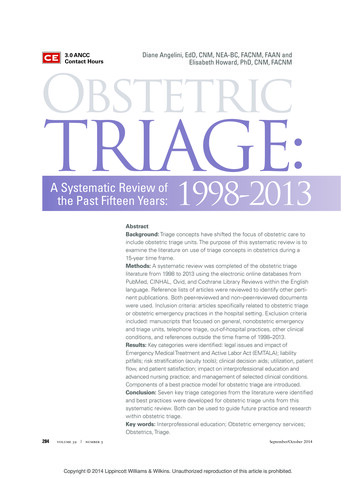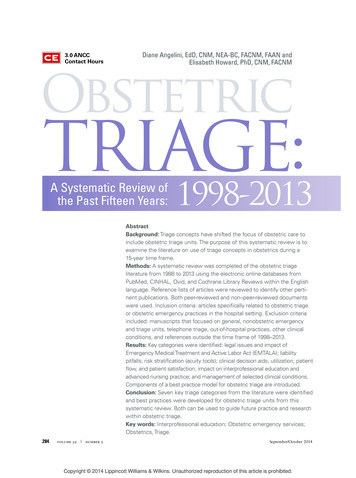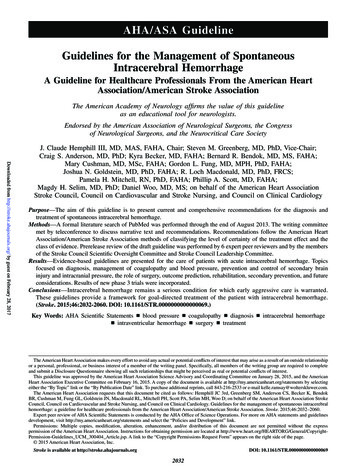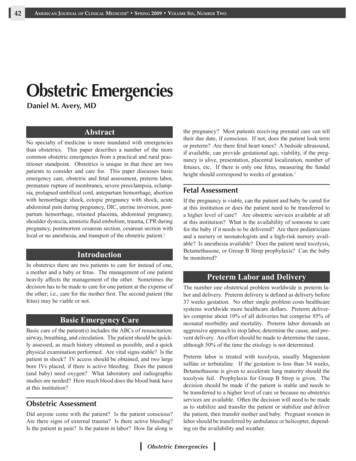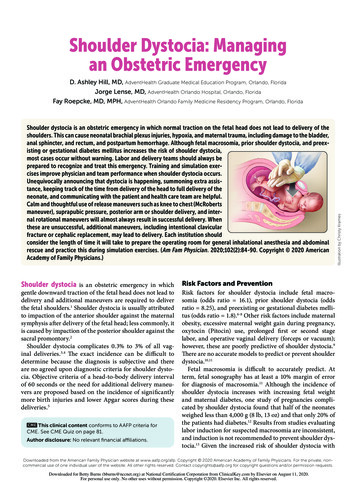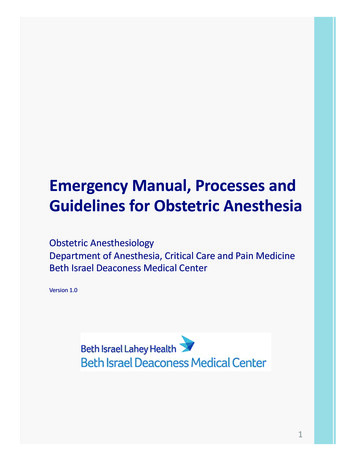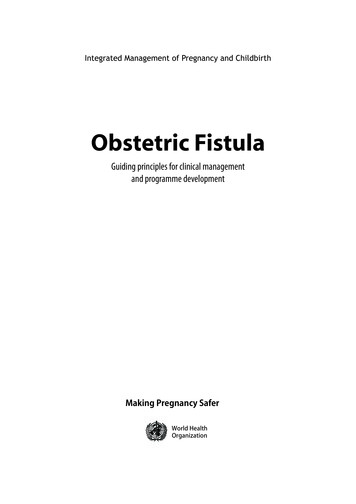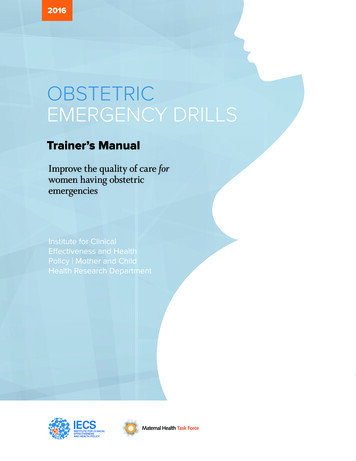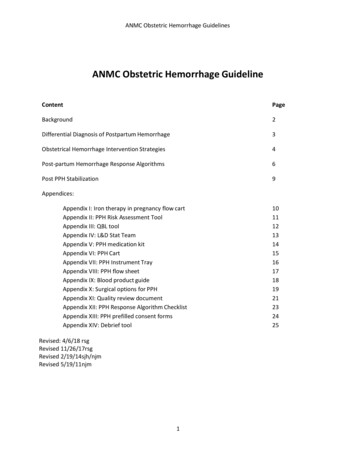
Transcription
ANMC Obstetric Hemorrhage GuidelinesANMC Obstetric Hemorrhage GuidelineContentPageBackground2Differential Diagnosis of Postpartum Hemorrhage3Obstetrical Hemorrhage Intervention Strategies4Post-partum Hemorrhage Response Algorithms6Post PPH Stabilization9Appendices:Appendix I: Iron therapy in pregnancy flow cartAppendix II: PPH Risk Assessment ToolAppendix III: QBL toolAppendix IV: L&D Stat TeamAppendix V: PPH medication kitAppendix VI: PPH CartAppendix VII: PPH Instrument TrayAppendix VIII: PPH flow sheetAppendix IX: Blood product guideAppendix X: Surgical options for PPHAppendix XI: Quality review documentAppendix XII: PPH Response Algorithm ChecklistAppendix XIII: PPH prefilled consent formsAppendix XIV: Debrief toolRevised: 4/6/18 rsgRevised 11/26/17rsgRevised 2/19/14sjh/njmRevised 5/19/11njm11011121314151617181921232425
ANMC Obstetric Hemorrhage GuidelinesANMC Obstetric Hemorrhage GuidelineBackgroundThe definition of early postpartum hemorrhage (PPH) is “Cumulative blood loss of 1000mlaccompanied by signs/symptoms of hypovolemia within 24h following the birth process”. PPH is anincreasing cause of maternal morbidity and mortality. It accounts for 30% of all maternal deathsworldwide and 10% of maternal deaths in the U.S. The rate of postpartum hemorrhage is steadilyincreasing throughout developed countries including the U.S. Between 1994 and 2006, pregnancyrelated hemorrhage in the U.S. has increased 26-27% and is now the leading cause of maternal death.The most common etiology for PPH ( 70-80%) is uterine atony, or a soft, non-contracted uterus. Othercauses include retained placenta, lacerations of perineum, vagina, cervix, uterus, retroperitoneum,uterine rupture, pre- existing coagulopathy (inherited or acquired). For a more detailed list, review thenext page on the differential diagnosis. Because most of the pregnant population is young and healthy,they don’t show signs of cardiovascular stress until the last stage of bleeding. Therefore, recognition ofblood loss before cardiovascular changes occur is paramount. Cardiovascular collapse in a young,healthy woman is an emergent, life-threatening situation, which can only be predicted by keeping trackof the blood loss throughout the labor course.Although 50% of the PPH occur in women without any risk factors, there is a group of patients who areat “high risk” of hemorrhage based on their medical or obstetrical history, including twin-gestation,large infants, long labors, prior uterine surgery and other risk factors indicated in the differentialdiagnosis below. Patient with a known or suspected abnormal placentation (placenta increta, percreta,accreta) are at extreme risk for PPH. For detailed management of these cases, review the ANMCGuideline: Abnormal placentation management.Due to the alarming increase in PPH events and the potential morbidity and mortality associated withPPH, it is prudent to develop a response system. This system includes standardization of risk factoridentification, guidelines on management, and continued training and evaluation of the care given toour patients. From expert reviews it is clear that the direct response to a PPH is multidisciplinary andshould be practiced as such in order to keep the tasks and responsibilities pragmatic and clear.This guideline is developed to be a centrally available tool to use for development and implementationof best practices, as well as a source of review regarding recognition and management of postpartumhemorrhage at ANMC. This guideline relied on information from protocols, guidelines and researchsummarized or done by the American College of Gynecologist (ACOG), the California Maternal QualityCare Collaborative (CMQCC) and World Health Organization.2
ANMC Obstetric Hemorrhage GuidelinesDifferential Diagnosis of Postpartum HemorrhageEffective management of postpartum hemorrhage requires understanding the potential causes. Thereare four main causes of postpartum hemorrhage that account for the majority of cases. Also known asthe “Four T’s”, these are Tone (uterine atony), Tissue (retained placenta), Trauma (laceration), andThrombin (coagulopathy).TONE/Uterine atony: Lack of active contraction of the uterine smooth muscle. Accounts for 70-80% ofpost-partum hemorrhage. Can be caused by: Infection – chorioamnionitis Prolonged induction of labor Prolonged oxytocin use Prolonged second stage of labor Over-distention – LGA, multi-fetal pregnancies, polyhydramnios Forceps delivery – especially mid-forceps or rotational forceps Previous history of PPH - regardless of etiology Multiparity – grand multiparity carries a 4x risk of PPH over baseline Uterine inversion Maternal infusion of magnesium sulfateTISSUE/Retained products of conception: Will cause uterine atony Amnion/chorion (fetal membranes) Abnormal placentation - accreta, increta, percreta, succenturiate lobe, cotyledon fracture Blood clotTRAUMA/Vascular and soft tissue injury: Higher occurrence of tissue trauma with precipitous first and second stages of labor Uterine, cervical, vaginal, perineal lacerations Increased risk with operative vaginal delivery Hematomas- vulvar, paravaginal, broad ligament, retroperitoneal Uterine rupture Non-visible internal bleeding (change in vital signs out of proportion to witnessed blood loss)THROMBIN/Coagulopathy: Inherited Acquired Dilutional - IVF infusion diluting effective clotting factors per ml “blood” Consumptive – Disseminated Intravascular Coagulopathy (DIC), Amniotic Fluid Embolism (AFE) A change of 0.2 of the INR suggests that almost 80% of clotting proteins have been used3
ANMC Obstetric Hemorrhage GuidelinesObstetrical Hemorrhage Intervention StrategiesWith current strategies in prenatal care and with modern birthing facilities, there are multipleopportunities to limit risk of PPH as well as maximize response to PPH.Antepartum:Pregnant patients experience a 50% increase in circulating blood volume by 24 weeks gestational age;this persists until delivery. Red blood cell (RBC) mass increases to a lesser degree (25%) than serumvolume causing a dilutional anemia. Additionally, there is a dilutional thrombocytopenia and to a lesserextent dilution of coagulation factors. Pregnancy increases iron requirements due to fetal needs as wellas maintenance of maternal red blood cell mass. The majority of women can account for iron needs inthe non-pregnant state by diet alone. The 2.5 fold increased need for iron during pregnancy is rarelyachieved with diet alone. The antepartum period is an opportunity to maximize maternal RBC mass aswell as iron stores. Studies clearly demonstrate that the less anemia and more iron stores a woman hasin late pregnancy, the less likely she is to suffer morbidity or need a blood transfusion, even in thesetting of mild to moderate PPH. There is a clinical guideline available for management of iron inpregnancy. See ANMC Anemia In Pregnancy Guideline. See Appendix I: Iron Therapy in Pregnancy.Admission:Every opportunity should be utilized to identify women at risk. However, despite the most robustidentification criteria and risk stratification, almost 50% of cases of maternal postpartum hemorrhagehave no identifiable risk factors. This supports the need for identification of those at risk as well aspreparedness for those who have no risk factors. Health facility admission represents an ideal time forscreening patients for risk factors. The risk assessment should be included on any SBAR (Situation,Background, Assessment, Recommendation) regarding the parturient. Please see Appendix II: PPH riskstratification with recommended management pathways. This risk assessment is dynamic and willchange throughout a patient’s labor, delivery and postpartum period. As new risk factors develop, thisalgorithm should be repeated. The presence of multiple risk factors should place them in the high-riskcategory.Prevention:The majority of obstetric literature endorses Pitocin as the single most effective management optionfor prevention/prophylaxis of postpartum hemorrhage. On the labor unit at ANMC, this is supplied premixed at a concentration of 30U Pitocin in 500ml NS for safety and standardization. Pitocin causescontraction of uterine smooth muscle, effectively closing the maternal circulation to the placentalinsertion site. It is recommended to initiate Pitocin infusion immediately after delivery of the neonate.Initial rate of infusion is 350ml/h for 30 minutes ( 10 units) after delivery of the neonate followed bycontinued infusion of Pitocin at 125ml/h for at least 4 more hours. There are no studies that endorsemisoprostol for prevention or prophylaxis; however, anecdotal findings suggest that this may be areasonable adjunct to Pitocin . Once Pitocin has begun, a response to continued postpartum bleedingshould progress in a standardized escalating manner that is at once thorough, simple, easy to follow,and effective. It is vital to practice these algorithms frequently so that response to an emergent processbecomes second nature. Early and accurate recognition of a postpartum hemorrhage can prompt atimely and potentially life-saving set of interventions.4
ANMC Obstetric Hemorrhage GuidelinesRecognition – Qualitative Blood Loss (QBL):Quantitation of blood loss at time of delivery has historically been based on a visual estimate by theprovider visual, called estimated blood loss (EBL). To stay ahead of obstetrical hemorrhagequantification of blood loss should be continuously documented from admission to the end of delivery.Quantification can be done by weighing any delivery materials soaked in blood, by measuring blood in abuttocks drape, and by keeping constant record of those measurements. See Appendix III: QBL tool.Strive to quantitate at every delivery. Every person in the labor room should be able to evaluate bloodloss and trigger responses as needed. Trigger points are graded I through IV with the first trigger pointat 500mL, followed by 1000mL, 1500mL and over 2000 mL. The details on management is outlinedbelow in the post-partum hemorrhage response algorithms. The response algorithms of theseescalating stages are important in effective communication and collaboration.Tips and tricks for QBL:1. For vaginal birth:a. Immediately after the birth of the baby, notify the amount of amniotic fluid in thedrape.b. At the completion of the delivery/recovery period weigh all blood clots and bloodsoaked materials (which are placed in a kick-bucket after usage) to determinecumulative volume.2. For cesarean birth:a. Be aware of the total irrigation fluid on the OR. Suction all irrigation fluid at the end ofthe procedure.b. Weight all sponges and laps; deduct the weight of the sponges and laps.c. Add the total amount of fluid in the suction canisterd. Deduct total irrigation fluid and deduct estimated amniotic fluid (see point 3).3. For birth without prior rupture of membranes, the following volumes can be used to estimatethe contribution of amniotic fluid at term: Brace, et al. found normal fluid volume 700 mL;oligohydramnios 300 mL; polyhydramnios 1400 mL.4. Unusual visual and auditory cues to excessive bleeding should be urgently investigated. Suchcues include blood on the floor, walls, or ceiling, blood dripping off of the bed, table, orstretcher, continuously vibrating suction tubing or continuous full suction.5. For all cases of ongoing hemorrhage, intake and output measurements should be documented,tallied, and reported to the team at frequent intervals (q5-15min). This data provides importantdirection to the team.6. Antepartum bleeding should be taken in account when assessing total blood loss.7. Labor and Delivery has under-the-buttocks drapes for delivery which have a calibratedgraduated collection bag. Use of this graduated collecting system has been demonstrated to bean accurate way to quantitate blood loss at delivery. For accurate quantification of blood loss, itis calibrated to measure fluids only when hanging off of the bed or when lifted up by theprovider to show the level of fluid collected.5
ANMC Obstetric Hemorrhage GuidelinesPOST-PARTUM HEMORRHAGE RESPONSE ALGORITHMSSTAGE I - QBL 500mL: Initial trigger pointRN 1 (primary RN): Notify Charge RN Increase Pitocin infusion rate to 500-999ml/hr. (10u IM Pitocin if no IV) DO NOT PUSH IV VS (pulse, BP, O2 saturation) frequently, state to providers when outside of normal Oxygen via facemask Stays at the bedside Keep patient warmth: Warm blankets Keeps charting, evaluating blood loss with providersCharge RN: Pages OB physician to room Anesthesia (PAGER 2222) to be “aware” Assigns RN 2 At any time the charge RN can call for the L&D Stat Team (Appendix IV)RN 2 (runner): Brings PPH medication kit, PPH cart and PPH instrument tray into the room (Appendix V, VI, VII) Brings the ultrasound to the room Ensure working second IV line, give medications as ordered by provider Ensure adequate lighting and that provider has instruments for laceration evaluation/repairSTAGE II - QBL 1000ml or 10-15% change in BP/pulse, O2 92RN 1 (primary RN): Notifies changes in BP/pulse, O2 sat or total QBL to the provider and Charge RN Continues with the above, stops charting when recorder is assigned and focusses on keepingpatient informed and comfortable. Assists anesthesia with line placement, blood product verification, intubation as needed.Charge RN: Notify House Supervisor (phone 1919) Anesthesia (pager 2222) to room Notify OR (phone 2275) and scrub tech (phone 8123) Assign: Recorder, Blood bank liaison, runner, family liaison/baby RN Order blood cross match STAT (2 units PRBC), sends lab request and calls labRN 2 (runner): IV access and medication administration and assists RN 1 in tasks.Scrub tech: Ensuring lighting, instruments and disposables: sutures and sponges. If warranted prepares OR.Recorder: Records all interventions with use of Appendix VIII, or time/intervention on any kind of paper.Baby RN becomes family liaison: Updates to family and/or escorts family pending on desires. Keeps neonate in safe situation.House Supervisor: Crowd control, contact additional services as indicated by the provider (Interventional radiologyx3100, GYN ONC x2300 etc). Calls backup OBGYN in the house.Anesthesia: Takes over IV access (PRN central line), pain control, I&O and medication administration.6
ANMC Obstetric Hemorrhage GuidelinesSTAGE III - QBL 1500ml, patient unstable, DIC, 2 Units PRBC givenAll of the above with:Charge RN/House Supervisor: All of the above. Activate Standby Massive Blood Transfusion Protocol (MBT)o Blood bank phone-1235 or 1223o Pull system: blood products available immediately from the lab Contact additional services as indicated by the provider (Interventional radiology, GYN ONCetc.) Calls backup OBGYN in house. Calls for additional assistance as needed.RN2 (runner): Nurse draws and sends MBT labs every 30-60 minso Coags and fibrinogen Light blue top tubeo CMPLight green top tube o Ionized CaABG syringe (venous blood)o CBCPurple top tubeSTAGE IV - QBL 2000ml, patient unstable, DIC, multiple blood products transfusedRN1 All the above SBAR to OR crew and other recent responders Stays in the OR for extra assistanceCharge RN/House Supervisor: All the above Activate Immediate Massive Blood Transfusion Protocol Push system: Blood products delivered to clinical area in bulk and used as needed Verify with provider need for GYN ONC/Interventional Radiology/ICU bedAnesthesia: Management of intubation, IV fluids, blood product infusion, analgesia/anesthesia Call for 2nd Anesthetist if needed Antibiotics pre-incision or post-sweep (per surgeon), repeat antibiotics if it was a CS.Operating room team: Receive SBAR from RN1 Takes over primary care of patient Coordinate transport to the operating suite Coordinate operating room function/personnel/equipment Analgesia: preferably with CNMA or Anesthesiologist in the room. Use of Epidural, IVFentanyl, Morphine, or Toradol, Tylenol. Realize that the latter two are the only medicationsnot affecting blood pressures. Nitrous Oxide could be used as well, however patient needs tobe fully capable of using the mask, furthermore with Nitrous Oxide the patient cannot receive100% oxygen.Provider Role throughout the stages I-IV: Orchestrate the resuscitation (for medications see Appendix V for blood products seeAppendix IX) Verbalize differential diagnosis to team Cessation of bleeding PROVIDER SHOULD CONSIDER THE 4 T’s (Tissue, Tone, Trauma, Thrombus – see next page).7
ANMC Obstetric Hemorrhage GuidelinesTISSUE: Evaluate the placenta for missing lobes. Manual sweep for clots or retained products, followed by a single dose Ampicillin or other 1stgeneration cephalosporin for infection prophylaxis within 1 hour of sweep. Bedside ultrasound for evaluation of endometrium. Uterine-inversion; stop Pitocin, replace uterus if possible if not give Nitroglycerine SL 1-2puffsjust prior to replacement of the uterus. If placenta still attached consider placenta accrete asdifferential and prepare as such (anesthesia, OR, blood products, Bakri-balloon and IR onstandby). TO OR IF NOT ABLE TO EVALUATE OR REMOVE PRODUCTS COMPLETELY IN LDRTONE: Uterine ATONY (See Appendix V: PPH medication kit) Uterine massage, make sure Pitocin is running Misoprostol 400mcg-1000mcg buccal or SL. If not able to tolerate, place rectally. Use of the 2 main injectable uterotonic medications per provider discretion 0.2mg IM Methergine (may repeat in x 1 in 15 minutes and again in 2h if effective)o CAUTION WITH HYPERTENSIONo Do not give if still suspicious of retained placenta, as it clamps down lower uterinesegment and may impede uterine evaluation. 250mcg Hemabate IMo CAUTION WITH ASTHMA.o Give with loperamide 4mg PO to prevent diarrhea Empty bladder with foley, consider leaving foley in place with urometer TO OR IF NOT ABLE TO EVALUATE OR IF ATONY IS IN NEED FOR SURGICAL MANAGEMENT*TRAUMA: Perineal, labial, vaginal, cervical or uterine lacerations Evaluate if repair is possible in L&D or the need for better lighting in the OR with dedicatedCNMA for pain control. Have extra hand from CNM/MD for retraction RN runner/scrub tech available for assistance in supply need (laps, sutures, instruments) Pain control can be given locally, lidocaine perineal block or local infiltration. TO OR IF NOT ABLE TO EVALUATE OR CONTINUED BLEEDING*THROMBUS: COAGULOAPTHIC:Replace with blood products. Typical ratios 6:4:1 PRBC:FFP:PLT Consider: Cryoprecipitate, Tranexamicacid (Lysteda ), rFactor VIIa (See Appendix VI)For all PPH 1000mls regardless of cause:WHO guidelines advises Tranexamic acid (lysteda) for all PPH to be given within 3 hours post partum,1 gram (100mg/ml IV to be given over 10 min) and repeat if ongoing PPH in 30 min or rebleed within24 hours. This is advised for all PPH 1000 mls. Only contraindication is known h/o thrombophilia onanticoagulation prophylaxis or active VTE in pregnancy. (see also appendix IX)IF PATIENT’S VITAL SIGNS SUGGEST SIGNIFICANTLY WORSE ANEMIA OR HYPOVOLEMIA THAN THEVISUALIZED/MEASURED BLOOD LOSS SUGGESTS, THIS IS CONCERNING FOR A RETROPERITONEAL ORINTERNAL BLEEDING. PATIENT SHOULD BE TAKEN TO LAPAROTOMY IMMEDIATELY.*SEE APPENDIX X: Surgical options for PPH8
ANMC Obstetric Hemorrhage GuidelinesPost PPH StabilizationRN Discuss with the provider if standard recovery is enough or whether more frequent fundal checksand vital signs are indicated Continue Pitocin at 350ml/h for 30 minutes, after 30 mins, change Pitocin to 125ml/h x 4 hours. If Methergine was effective, consider an oral Methergine series for 24h Blood products that have been pulled but not used must be “released” back to the blood bankProvider: Management should be tailored to the etiology of the bleeding event, and co-existing conditions. After massive transfusion, intense fluid resuscitation or need for respiratory or vasopressor support,management should be with an intensivist in the ICU. Although counterintuitive, post massive transfusion patients are at higher risk of VTE and shouldreceive appropriate prophylaxis with SCDs, early ambulation and SQ heparin. Consider an incentive spirometer for recovery, specifically if the patient was ventilated or intubatedat some point during the resuscitation, even if not a surgical management was required. After a hemorrhage event, proper documentation of the event including blood loss, interventionsand outcomes should be documented in the patient chart. (Appendix X: Quality review documentto guide your documentation.) Debrief the situation with those who were involved. (Appendix XIII: Debrief tool) Email the SCF PPH EVENT the MRN and providers involved for quality assurance evaluations. The provider should meet with the patient to explain the event, provide support, and answerquestions for the family members. Preferably this meeting is documented in the chart. Organize follow-up in 1-2 weeks post-event for anemia check and mental wellbeing.Charge RN Receive call from Lab to determine status of unused blood.9
ANMC Obstetric Hemorrhage GuidelinesAppendix I: Iron therapy in pregnancy10
ANMC Obstetric Hemorrhage GuidelinesAppendix II: PPH Risk Assessment Tool11
ANMC Obstetric Hemorrhage GuidelinesAppendix III: QBL toolThe following is a chart of typical products found on Labor and Delivery which may become bloodsoaked during a delivery. To quantitate blood loss from these products, the dry-weights have beenmeasured. Using a 1gm:1ml conversion, the total weight is measured and the dry weight subtracted,leaving the weight of blood.ITEMDry weight(grams)Blue chuxLight blue chuxGreen chuxPeach chuxRay-tek spongeLap spongeBlue towelGreen towelPeach/pink peripadWhite peri-padWhite “oldfashioned” peri-padCloth bed padLarge linen towelWashclothGraduated drapevolume452070100520608030Number used(per category)Total dryweight:All percategoryTotal wetweight:All percategoryWet weightdry weight:blood loss inml.101534536035SubtractpredeliveryfluidsSubtract urine,irrigation afterdeliveryTOTAL QBL Updated weights April 2016, includes RF tagged products12
ANMC Obstetric Hemorrhage GuidelinesAppendix IV: L&D Stat TeamIn any given clinical situation on the Labor and Delivery, the L&D Stat Team is appropriate and furtherhands on deck can be called in separately. In the specific case of a PPH the Pediatric team may beinformed that their assistance is not necessary or just limited to temporarily take care of the newbornwhile the focus of the L&D team is on the mother’s wellbeing.Call 1111: Ask for L&D Stat Team and state location of emergency.The L&D Stat Team includes the following members: Patient primary RN (RN1) OBGYN physician on duty CNM on L&D duty Scrub tech L&D charge RN Mother-Baby Unit RN (RN2) House supervisor Anesthesia staff on duty Respiratory Therapy on duty Pediatrician on duty Inpatient Pediatric Unit Charge RN Neonatal Intensive Care Unit RNWhen the operator is asked to call for an L&D Stat Team this will be communicated with an overheadpage, which will be repeated 3 times. The on call OBGYN, Pediatrician and Anesthesia on duty will alsoreceive a page.The L&D Stat Team does not include an ICU doctor and is not the same as a rapid response or code.With a Rapid Response the ICU nursing team, plus house supervisor and the respiratory therapist iscalled, for quick response to a rapid declining clinical situation.With a Code Blue, which is appropriate for unresponsive, pulseless adult patients on L&D the housesupervisor, ICU nursing team (ACLS trained), anesthesia, pharmacist and the respiratory therapist iscalled.13
ANMC Obstetric Hemorrhage GuidelinesAppendix V: PPH medication kitThis “kit” contains single doses of the medications (see below) most useful for management of PPH(with exception of Pitocin ). There is also a hemorrhage cart that includes syringes, needles and alcoholswabs to minimize the time to administer an injection. Two of the medications in this kit must berefrigerated; thus the kits are located in the refrigerator in the medication room on Labor and Delivery.The critical trigger point of 500mL quantification of blood loss prompts this “kit” being brought to thebedside automatically.Uterotonic Medication GuideMEDICATIONoxytocin(Pitocin )DOSE30units in 500mlNSIV infusion350ml/h x 30min125ml/h x4hmethergonovine(Methergine )0.2mgcarboprostprostaglandin E2(Hemabate )250mcgmisoprostolprostaglandin E1(Cytotec )400-1000mcgROUTEIVPB preferred10units IM (using10 unit/mL 1mLvial) in anemergencyNEVER PUSH IVIMNot given IVIMNot given IVBuccal, SL, or PRFREQUENCYContinuous IVpiggyback,premixedOTHERNO IV PUSHHyponatremia andH2O overload withhigh doses orprolonged useRepeat (X 1) 15minutes after 1stdose. Every 2-4hthereafter.Max dose is 5 totaldoses in a 24 hourperiodEvery 15-90minutesMax 8 doses in24hContraindicatedwith currenthypertension,cardiac disease orrecent ephedrineuseMay giveloperamide dicatedwith active cardiacor respiratorydiseaseTransienthyperthermia.Unlikely to work ifHemabate ineffectiveMisoprostol Pharmacokinetics:SL or Buccal: These are the preferred routes for acute bleeding – most rapid onset, most prolonged duration,greatest bioavailability: 400mcg SL fewest side effects and equivalent efficacy to higher doses.Half-life 20-40min. WHO recommends 800mcg SL; PO- 2nd line for acute bleeding, slower onset than SL; PR:Helpful in prevention, or for anticipated delayed PPH (variable, weak recommendations); *PR not effective ifcopious diarrhea from Hemabate 14
ANMC Obstetric Hemorrhage GuidelinesAppendix XI: PPH CartsOn the inpatient OB floor, there are several “Hemorrhage carts” located in clinical areas. These cartsshould be brought to the location of a PPH event with the initial trigger of 500mL. Carts are located inthe following areas: Labor and Delivery: This cart is located at the nurse’s station on Labor and Delivery. It can beused to cover emergencies on Labor and Delivery as well as in OB Triage. Annex: nurse’s station MBU: Located in a cubby in the hallway on the Mother-Baby Unit. On Hold: There will always be one cart on hold in Central Supply (CS). Once a cart is used, itshould be traded for the one held in CS. At that point, it will be restocked up to PAR level.Most equipment needed to manage an acute PPH event should be located on the cart. This includes: IV fluids and tubing IV start supplies Urinary foley catheter and collecting system Blood draw tubes Bakri balloon, Kerlix and fluid/syringes Headlamp for adequate lighting if needed Scale to measure QBL by weightThe PPH Instrument Tray is in the medication room see next page for content.15
ANMC Obstetric Hemorrhage GuidelinesAppendix VII: PPH Instrument Tray (Available in medication room)Instrument NameNumberQuantityStraight Sponge ForcepsGL6502Uterine Tenaculum ForcepsGL8501CH24421Uterine Packing Forceps CurvedGL60011x2 Tissue Forceps 10"SU23371Russian Tissue Forceps 10"SU24542Gelpi Retractor 7 1/2"GA5002Heaney Simon Retractor 4 1/2x1"GL3502Breitsky-Navratil Retractor 12"GL4672STEAM INDICATOR, Class D264101ER628RGL16251Needle Holder Straight Jaws Carbide inserts 10 3/8"Banjo Curette161
ANMC Obstetric Hemorrhage GuidelinesAppendix VIII: PPH flow sheet17
ANMC Obstetric Hemorrhage GuidelinesAppendix IX: Blood product guideBlood Product GuidePRODUCTPacked Red Blood CellsVOLUME450mlEXPECTED RESULTIncrease Hgb by 1gmand HCT by 3%Fresh Frozen Plasma180mlIncrease fibrinogen by10mg/dlCryoprecipitateIncrease in fibrinogen80-100mg/dlPlateletsIncrease platelets by40-50kTransientOTHERIf AB screen , may take1-24 hours for acrossmatch1:1 or 2:1 PRBCstransfused. Use if PT orPTT 1.5x normal30-45min thawPriority for fibrinogen 80. Pooled donorsPriority for plt 50kSingle dose is a “6-pack”Do not wait for lab results if transfusion is indicated by clinical signs (vitals) and QBL.Typical ratios6:4:1 PRBC:FFP:PLTOr6:6:1 PRBC:FFP:PLTFor low fibrinogen use cryoprecipitate to target fibrinogen 300In cases where high risk of coagulopathy exist (for reasons other than dilutional), attempt to mimicwhole bloodratios is supported by various studies. In other cases, direction of component therapy by explicitassessment ofcoagulopathy by either specific clinical or lab criteria is preferred. If bleeding and replacement go onlongenough, factor replacement due to dilution will eventually be needed. rFactor VIIa: 70-100mcg/kg IVPB. May repeat in 1 and 3 hours if bleeding continueso Off label useo No significant obstetric data. Use based on trauma and surgical cases with massiveintraoperative blood losso Conflicting evidence regarding thrombotic events post-administration (all uses, 95% offlabel) 2-10%o 70-100mcg/kgFor all PPH 1000mls regardless of cause:oTranexamic acid (Lysteda) to be given within 3 hours post partumo1 gram total (100mg/ml IV to be given over 10 min)oRepeat if ongoing PPH in 30 min or rebleed within 24 hours.oContraindication is known h/o thrombophilia on anticoagulation prophylaxis or active VTE inpregnancy. 18
ANMC Obstetric Hemorrhage GuidelinesAppendix X: Surgical Options for PPHSurgical OptionsGoal of surgical management is cessation of bleeding and vascular stability. Identification of source isparamount. Again, consider the 4 T’s: Tone, Tissue, Trauma, Thrombin. Tone: If bleeding is from atony and a Bakri has not been placed, perform a uterine curettageand place a Bakri. Place the balloon, fill with 500cc saline, assure correct placent and pack thevagina with Kerlix. Some will pack the vagina first and then inflate the Bakri to keep the Bakri inthe uterus however be sure the Bakri is not only in the lower uterine segment. Secure thevaginal pack to the Bakri. Attach a foley bag to drain outlet for Bakri and label as “Uterine”.o Review atony medications and use as indicatedo Foley catheter for bladder drainageo
ANMC Obstetric Hemorrhage Guidelines 6 POST-PARTUM HEMORRHAGE RESPONSE ALGORITHMS STAGE I - QBL 500mL: Initial trigger point RN 1 (primary RN): Notify Charge RN Increase Pitocin infusion rate to 500-999ml/hr. (10u IM Pitocin if no IV) DO NOT PUSH IV VS (pulse, BP, O2 saturation) frequently, state to providers when outside of normal


